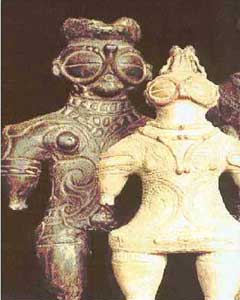|
|
|
by Vaughn Greene from AtlantisRising Website
A few weeks after I wrote Arnold, two friendly FBI agents came for a visit. Here was I, a 17-year-old punk, being interviewed by investigators who were not very sympathetic.
This only whetted my appetite, and over the years I contacted some of the early flying saucer buffs, including,
...and others.
While
stationed in Japan, I began studying early Shinto legends and
ancient mythology. To my surprise, these early tomes were loaded
with references to aerial battles, underwater castles,
What
really impressed me were some prehistoric statues called dogu.
Dogus were made by a Neolithic people called the Jomon, who were the first persons on earth to make clay pottery.
Dating back as far as 12,000 to 14,000 years per R-14 dating, the earliest dogu were very crude.
The last ones over 2,500 years ago showed a sharp, machine-tooled look.
I've found over 30 points of similarity to modern space suits on dogus, including lenses, rivets, rubber cuffs, chest controls, safety straps, communication lights, etc.
Can this be mere coincidence?
Since
that time, the experts have called them sex objects, funeral
depictions, etc. The best explanation I think is the word dogu which
in Japanese means a tool.
The 7,000-year-old drawings at Val Camonica, Italy, the prehistoric Tassali, Sahara, and ancient Australian Aborigine sketches all show helmeted, suited-up figures.
There are statues, such as,
...hich show similar features.
Figurines of the 8,000-year-old Mohenjo Daro culture in India are almost identical.
The most remarkable
similarity though, relates to
the Kappa.
The Kappa
These mischievous creatures swam underwater, had webbed feet (swim fins?), and flew around in shell cars.
The Kappa
often came ashore and taught the natives various advanced arts. What
is remarkable about this is that there are at least three similar
stories found around the earth.
This is partly the basis for legends of Parsifal, the Spear of Destiny, and mysterious tools used by the Knights Templar. A second legend relates to the Oannes, half-human creatures seen in olden Babylonia.
These beings came out of the sea every day to teach the world's first agriculture, mathematics, law, and astronomy.
Every evening they would dive back into the water. Drawings show them wearing wrist watches and holding what looks like a rocket motor.
A third group visited the Dogon tribe of Mali, Africa.
The oldest hot spring in Japan is
called Dogon. I have found, in checking, about a dozen words of
Dogon and Japanese which are virtually identical.
They told the Dogon their ships came from a
planet circling a dwarf star near
the star Sirius. Our astronomers
did not locate this star until 1952.
Note that the names of these water-living creatures Nommo, Oannes, and Kappa all have a double consonant. It is interesting that Japanese mythology is full of stories about underwater creatures (Umi Bozo) and others who engage in aerial warfare (the Ashura).
There are stories of underwater castles seen on a clear day at the Inland Sea. Underwater lights have been seen in Yasushro Bay for over 1,000 years. In ancient times three suns appeared in the sky.
A saucer-shaped craft landed
and a blonde woman was seen inside. Japan's greatest saint Nichirin
Diashonin was saved from beheading when a meteor streaked over the
frightened executioners.
There are several Internet web sites called dogu and Jomon, but I have found them to be almost useless.
In July 1997 a Japanese artist displayed in San Francisco a statue which was obviously made to ridicule dogus.
The largest tomb in the world, over a half mile long, sits in Japan, some would argue, like a huge space beacon.
This keyhole-shaped
structure has never been opened, it is claimed. Is there any
relationship here with the
recently discovered underwater pyramids
recently discovered off Japan?
|


